Co-Ce Clay-Based Materials: Their Feasibility as Catalysts for Soot and CO Oxidation Reactions
Abstract
1. Introduction
2. Results and Discussion
2.1. Bare Clay Characterization
2.2. Catalyst Characterization
2.3. Catalytic Activity
2.3.1. Soot Combustion
2.3.2. CO Oxidation
3. Material and Methods
3.1. Preparation of Supported Catalysts
3.2. Characterization
3.2.1. Specific Surface Area
3.2.2. Thermogravimetric Analysis (TGA, DTA)
3.2.3. X-Ray Fluorescence (XRF)
3.2.4. X-Ray Diffraction (XRD)
3.2.5. Fourier Transform Infrared Spectroscopy (FTIR)
3.2.6. Raman Spectroscopy (RS)
3.2.7. H2 Temperature-Programmed Reduction (H2-TPR)
3.2.8. X-Ray Photoelectron Spectroscopy (XPS)
3.3. Catalytic Tests
3.3.1. Soot Combustion
3.3.2. CO Oxidation
4. Conclusions
Author Contributions
Funding
Data Availability Statement
Conflicts of Interest
References
- Guggenheim, S.; Martin, R.T. Definition of Clay and Clay Mineral: Joint Report of the Aipea Nomenclature and CMS Nomenclature Committees. Clays Clay Miner. 1995, 43, 255–256. [Google Scholar] [CrossRef]
- Ma, G.; Xiao, Y.; He, X.; Li, J.; Chu, J.; Liu, H. Kaolin-Nucleation-Based Biotreated Calcareous Sand through Unsaturated Percolation Method. Acta Geotech. 2022, 17, 3181–3193. [Google Scholar] [CrossRef]
- Zhang, J.; Mallants, D.; Brady, P.V. Molecular Dynamics Study of Uranyl Adsorption from Aqueous Solution to Smectite. Appl. Clay Sci. 2022, 218, 106361. [Google Scholar] [CrossRef]
- Liu, L.; Wang, X.; Fang, W.; Li, X.; Shan, D.; Dai, Y. Adsorption of Metolachlor by a Novel Magnetic Illite–Biochar and Recovery from Soil. Environ. Res. 2022, 204, 111919. [Google Scholar] [CrossRef] [PubMed]
- Feng, Y.; Chu, G.; Xiao, B.; Li, R.; Deng, C.; Li, G.; Shi, H. Chlorite Mineralogy, Geochemistry and Exploration Implications: A Case Study of the Xiaokelehe Porphyry Cu-Mo Deposit in NE China. Ore Geol. Rev. 2022, 140, 104568. [Google Scholar] [CrossRef]
- Fan, W.K.; Tahir, M. Structured Clay Minerals-Based Nanomaterials for Sustainable Photo/Thermal Carbon Dioxide Conversion to Cleaner Fuels: A Critical Review. Sci. Total Environ. 2022, 845, 157206. [Google Scholar] [CrossRef]
- Nagendrappa, G. Organic Synthesis Using Clay and Clay-Supported Catalysts. Appl. Clay Sci. 2011, 53, 106–138. [Google Scholar] [CrossRef]
- Ismail, U.M.; Vohra, M.S.; Onaizi, S.A. Adsorptive Removal of Heavy Metals from Aqueous Solutions: Progress of Adsorbents Development and Their Effectiveness. Environ. Res. 2024, 251, 118562. [Google Scholar] [CrossRef] [PubMed]
- Huang, J.; Zhang, Y.; Hao, Z.; Zhang, Y. Preparation of Rare Earth Metal Ions Promoted MnOx@halloysite Catalyst for Highly Efficient Catalytic Oxidation of Toluene. Appl. Clay Sci. 2023, 244, 107081. [Google Scholar] [CrossRef]
- Torres, M.; de los Santos, C.; Portugau, P.; Yeste, M.D.P.; Castiglioni, J. Utilization of a PILC-Al Obtained from Uruguayan Clay as Support of Mesoporous MnOx-Catalysts on the Combustion of Toluene. Appl. Clay Sci. 2021, 201, 105935. [Google Scholar] [CrossRef]
- Huang, A.; He, J.; Feng, J.; Huang, C.; Yang, J.; Mo, W.; Su, X.; Zou, B.; Ma, S.; Lin, H.; et al. A High-Efficiency Clay Mineral Based Organic Photocatalyst towards Photodegradation of Butyl Xanthate in Mineral Processing Wastewater. Sep. Purif. Technol. 2024, 349, 127880. [Google Scholar] [CrossRef]
- Zamisa, M.K.; Seadira, T.W.; Baloyi, S.J. Transforming Wastewater Treatment: Recent Advancements in Catalytic Wet Air Oxidation with Pillared Clay Catalysts for Phenol Remediation. Environ. Pollut. 2024, 361, 124842. [Google Scholar] [CrossRef] [PubMed]
- Ramírez, J.H.; Galeano, L.A. Natural Organic Matter Removal by Heterogeneous Catalytic Wet Peroxide Oxidation (CWPO). In Applications of Advanced Oxidation Processes (AOPs) in Drinking Water Treatment. The Handbook of Environmental Chemistry; Springer: Cham, Switzerland, 2017; pp. 69–98. [Google Scholar]
- Heidari, A.; Shahbazi, A.; Aminabhavi, T.M.; Barceló, D.; Rtimi, S. A Systematic Review of Clay-Based Photocatalysts for Emergent Micropollutants Removal and Microbial Inactivation from Aqueous Media: Status and Limitations. J. Environ. Chem. Eng. 2022, 10, 108813. [Google Scholar] [CrossRef]
- Vajglová, Z.; Simakova, I.L.; Eränen, K.; Mäki-Arvela, P.; Kumar, N.; Peurla, M.; Tolvanen, S.; Efimov, A.; Hupa, L.; Peltonen, J.; et al. The Physicochemical and Catalytic Properties of Clay Extrudates in Cyclization of Citronellal. Appl. Catal. A Gen. 2022, 629, 118426. [Google Scholar] [CrossRef]
- Boukhemkhem, A.; Bedia, J.; Belver, C.; Molina, C.B. Degradation of Pesticides by Heterogeneous Fenton Using Iron-Exchanged Clays. Catal. Commun. 2023, 183, 106771. [Google Scholar] [CrossRef]
- Liu, H.; Da Costa, P.; Hadj Taief, H.B.; Benzina, M.; Gálvez, M.E. Ceria and Zirconia Modified Natural Clay Based Nickel Catalysts for Dry Reforming of Methane. Int. J. Hydrogen Energy 2017, 42, 23508–23516. [Google Scholar] [CrossRef]
- Álvarez, A.; Moreno, S.; Molina, R.; Ivanova, S.; Centeno, M.A.; Odriozola, J.A. Gold Supported on Pillared Clays for CO Oxidation Reaction: Effect of the Clay Aggregate Size. Appl. Clay Sci. 2012, 69, 22–29. [Google Scholar] [CrossRef]
- Sacco, N.A.; Banús, E.D.; Bortolozzi, J.P.; Milt, V.G.; Miró, E.E. Ultrasound-Assisted Deposition of Co–CeO2 onto Ceramic Microfibers to Conform Catalytic Papers: Their Application in Engine Exhaust Treatment. ACS Omega 2018, 3, 18334–18342. [Google Scholar] [CrossRef]
- Zhai, G.; Wang, J.; Chen, Z.; An, W.; Men, Y. Boosting Soot Combustion Efficiency of Co3O4 Nanocrystals via Tailoring Crystal Facets. Chem. Eng. J. 2018, 337, 488–498. [Google Scholar] [CrossRef]
- Leonardi, S.A.; Zanuttini, M.A.; Miró, E.E.; Milt, V.G. Catalytic Paper Made from Ceramic Fibres and Natural Ulexite. Application to Diesel Particulate Removal. Chem. Eng. J. 2017, 317, 394–403. [Google Scholar] [CrossRef]
- Nascimento, L.F.; Lima, J.F.; de Sousa Filho, P.C.; Serra, O.A. Effect of Lanthanum Loading on Nanosized CeO2-ZnO Solid Catalysts Supported on Cordierite for Diesel Soot Oxidation. J. Environ. Sci. 2018, 73, 58–68. [Google Scholar] [CrossRef] [PubMed]
- Gao, Y.; Wu, X.; Liu, S.; Weng, D.; Ran, R. MnOx–CeO2 Mixed Oxides for Diesel Soot Oxidation: A Review. Catal. Surv. Asia 2018, 22, 230–240. [Google Scholar] [CrossRef]
- Zhang, S.; Zhu, X.; Zheng, C.; Hu, D.; Zhang, J.; Gao, X. Study on Catalytic Soot Oxidation over Spinel Type ACo2O4 (A = Co, Ni, Cu, Zn) Catalysts. Aerosol Air Qual. Res. 2017, 17, 2317–2327. [Google Scholar] [CrossRef]
- Liu, S.; Wu, X.; Weng, D.; Ran, R. Ceria-Based Catalysts for Soot Oxidation: A Review. J. Rare Earths 2015, 33, 567–590. [Google Scholar] [CrossRef]
- Bensaid, S.; Russo, N.; Fino, D. CeO2 Catalysts with Fibrous Morphology for Soot Oxidation: The Importance of the Soot–Catalyst Contact Conditions. Catal. Today 2013, 216, 57–63. [Google Scholar] [CrossRef]
- Cheng, Z.; Chen, Z.; Li, J.; Zuo, S.; Yang, P. Mesoporous Silica-Pillared Clays Supported Nanosized Co3O4-CeO2 for Catalytic Combustion of Toluene. Appl. Surf. Sci. 2018, 459, 32–39. [Google Scholar] [CrossRef]
- Tuler, F.E.; Portela, R.; Ávila, P.; Bortolozzi, J.P.; Miró, E.E.; Milt, V.G. Development of Sepiolite/SiC Porous Catalytic Filters for Diesel Soot Abatement. Microporous Mesoporous Mater. 2016, 230, 11–19. [Google Scholar] [CrossRef]
- Meng, Z.; Chen, C.; Li, J.; Fang, J.; Tan, J.; Qin, Y.; Jiang, Y.; Qin, Z.; Bai, W.; Liang, K. Particle Emission Characteristics of DPF Regeneration from DPF Regeneration Bench and Diesel Engine Bench Measurements. Fuel 2020, 262, 116589. [Google Scholar] [CrossRef]
- Chen, C.; Yao, A.; Yao, C.; Qu, G. Experimental Study of the Active and Passive Regeneration Procedures of a Diesel Particulate Filter in a Diesel Methanol Dual Fuel Engine. Fuel 2020, 264, 116801. [Google Scholar] [CrossRef]
- Makó, É.; Kristóf, J.; Horváth, E.; Vágvölgyi, V. Kaolinite–Urea Complexes Obtained by Mechanochemical and Aqueous Suspension Techniques—A Comparative Study. J. Colloid Interface Sci. 2009, 330, 367–373. [Google Scholar] [CrossRef]
- Ilic, B.; Mitrovic, A.; Milicic, L. Thermal Treatment of Kaolin Clay to Obtain Metakaolin. Hem. Ind. 2010, 64, 351–356. [Google Scholar] [CrossRef]
- Fabbri, B.; Gualtieri, S.; Leonardi, C. Modifications Induced by the Thermal Treatment of Kaolin and Determination of Reactivity of Metakaolin. Appl. Clay Sci. 2013, 73, 2–10. [Google Scholar] [CrossRef]
- Sun, Q.; Zhang, W.; Qian, H. Effects of High Temperature Thermal Treatment on the Physical Properties of Clay. Environ. Earth Sci. 2016, 75, 610. [Google Scholar] [CrossRef]
- Fernandez, R.; Martirena, F.; Scrivener, K.L. The Origin of the Pozzolanic Activity of Calcined Clay Minerals: A Comparison between Kaolinite, Illite and Montmorillonite. Cem. Concr. Res. 2011, 41, 113–122. [Google Scholar] [CrossRef]
- Elimbi, A.; Tchakoute, H.K.; Njopwouo, D. Effects of Calcination Temperature of Kaolinite Clays on the Properties of Geopolymer Cements. Constr. Build. Mater. 2011, 25, 2805–2812. [Google Scholar] [CrossRef]
- Manoharan, C.; Sutharsan, P.; Dhanapandian, S.; Venkatachalapathy, R. Spectroscopic and Thermal Analysis of Red Clay for Industrial Applications from Tamilnadu, India. J. Mol. Struct. 2012, 1027, 99–103. [Google Scholar] [CrossRef]
- Madejová, J. FTIR Techniques in Clay Mineral Studies. Vib. Spectrosc. 2003, 31, 1–10. [Google Scholar] [CrossRef]
- Franco, F.; Cecila, J.A.; Pérez-Maqueda, L.A.; Pérez-Rodríguez, J.L.; Gomes, C.S.F. Particle-Size Reduction of Dickite by Ultrasound Treatments: Effect on the Structure, Shape and Particle-Size Distribution. Appl. Clay Sci. 2007, 35, 119–127. [Google Scholar] [CrossRef]
- Zhang, Z.; Qiao, X.; Yu, J. Microwave Selective Heating-Enhanced Reaction Rates for Mullite Preparation from Kaolinite. RSC Adv. 2014, 4, 2640–2647. [Google Scholar] [CrossRef]
- Venkatachalapathy, R.; Sridharan, T.; Dhanapandian, S.; Manoharan, C. Determination of Firing Temperature of Ancient Potteries by Means of Infrared and Mossbauer Studies. Spectrosc. Lett. 2002, 35, 769–779. [Google Scholar] [CrossRef]
- Elsass, F.; Olivier, D. Infra Red and Electron Spin Resonance Studies of Clays Representative of the Sedimentary Evolution of the Basin of Autun. Clay Miner. 1978, 13, 299–308. [Google Scholar] [CrossRef]
- Russell, J.D.; Fraser, A.R. Infrared Methods. In Clay Mineralogy: Spectroscopic and Chemical Determinative Methods; Springer: Dordrecht, The Netherlands, 1994; pp. 11–67. [Google Scholar]
- Kodama, H. Infrared Spectra of Minerals: Reference Guide to Identification and Characterization of Minerals for the Study of Soils; Agriculture Canada Research Branch: Ottawa, ON, Canada, 1985; Volume 1, p. 198. [Google Scholar]
- Mehta, N.; Gaëtan, J.; Giura, P.; Azaïs, T.; Benzerara, K. Detection of Biogenic Amorphous Calcium Carbonate (ACC) Formed by Bacteria Using FTIR Spectroscopy. Spectrochim. Acta Part A Mol. Biomol. Spectrosc. 2022, 278, 121262. [Google Scholar] [CrossRef] [PubMed]
- Enríquez, E.; del Campo, A.; Reinosa, J.J.; Konstantopoulos, G.; Charitidis, C.; Fernández, J.F. Correlation between Structure and Mechanical Properties in α-Quartz Single Crystal by Nanoindentation, AFM and Confocal Raman Microscopy. J. Mater. Res. Technol. 2023, 26, 2655–2666. [Google Scholar] [CrossRef]
- Kingma, K.J.; Hemley, R.J. Raman Spectroscopic Study of Microcrystalline Silica. Am. Mineral. 1994, 79, 269–273. [Google Scholar]
- Cardenas-Flechas, L.J.; Freire, P.T.C.; Paris, E.C.; Moreno, L.C.; Joya, M.R. Temperature-Induced Structural Phase Transformation in Samples of Co3O4 and Co3-XNixO4 for CoO. Materialia 2021, 18, 101155. [Google Scholar] [CrossRef]
- Vauchy, R.; Hirooka, S.; Watanabe, M.; Yokoyama, K.; Sunaoshi, T.; Yamada, T.; Nakamichi, S.; Murakami, T. Liquid Phase Sintering of Alumina–Silica Co-Doped Cerium Dioxide CeO2 Ceramics. Ceram. Int. 2023, 49, 3058–3065. [Google Scholar] [CrossRef]
- Kulal, N.; Bhat, S.S.; Hugar, V.; Mallannavar, C.N.; Lee, S.-C.; Bhattacharjee, S.; Vetrivel, R.; Shanbhag, G.V. Integrated DFT and Experimental Study on Co3O4/CeO2 Catalyst for Direct Synthesis of Dimethyl Carbonate from CO2. J. CO2 Util. 2023, 67, 102323. [Google Scholar] [CrossRef]
- Feng, X.; Luo, F.; Chen, Y.; Lin, D.; Luo, Y.; Xiao, L.; Liu, X.; Sun, X.; Qian, Q.; Chen, Q. Boosting Total Oxidation of Propane over CeO2@Co3O4 Nanofiber Catalysts Prepared by Multifluidic Coaxial Electrospinning with Continuous Grain Boundary and Fast Lattice Oxygen Mobility. J. Hazard. Mater. 2021, 406, 124695. [Google Scholar] [CrossRef]
- Jozwiak, W.K.; Kaczmarek, E.; Maniecki, T.P.; Ignaczak, W.; Maniukiewicz, W. Reduction Behavior of Iron Oxides in Hydrogen and Carbon Monoxide Atmospheres. Appl. Catal. A Gen. 2007, 326, 17–27. [Google Scholar] [CrossRef]
- Xu, J.; Lu, G.; Guo, Y.; Guo, Y.; Gong, X.-Q. A Highly Effective Catalyst of Co-CeO2 for the Oxidation of Diesel Soot: The Excellent NO Oxidation Activity and NOx Storage Capacity. Appl. Catal. A Gen. 2017, 535, 1–8. [Google Scholar] [CrossRef]
- Choya, A.; de Rivas, B.; González-Velasco, J.R.; Gutiérrez-Ortiz, J.I.; López-Fonseca, R. Oxidation of Lean Methane over Cobalt Catalysts Supported on Ceria/Alumina. Appl. Catal. A Gen. 2020, 591, 117381. [Google Scholar] [CrossRef]
- Aroldy, P. Temperature-Programmed Reduction of CoO/AI2O3 Catalysts. J. Catal. 1985, 93, 38–54. [Google Scholar] [CrossRef]
- Konsolakis, M.; Sgourakis, M.; Carabineiro, S.A.C. Surface and Redox Properties of Cobalt–Ceria Binary Oxides: On the Effect of Co Content and Pretreatment Conditions. Appl. Surf. Sci. 2015, 341, 48–54. [Google Scholar] [CrossRef]
- Tang, C.-W.; Wang, C.-B.; Chien, S.-H. Characterization of Cobalt Oxides Studied by FT-IR, Raman, TPR and TG-MS. Thermochim. Acta 2008, 473, 68–73. [Google Scholar] [CrossRef]
- Harrison, P.G.; Ball, I.K.; Daniell, W.; Lukinskas, P.; Céspedes, M.; Miró, E.E.; Ulla, M.A. Cobalt Catalysts for the Oxidation of Diesel Soot Particulate. Chem. Eng. J. 2003, 95, 47–55. [Google Scholar] [CrossRef]
- Xue, L.; Zhang, C.; He, H.; Teraoka, Y. Catalytic Decomposition of N2O over CeO2 Promoted Co3O4 Spinel Catalyst. Appl. Catal. B Environ. 2007, 75, 167–174. [Google Scholar] [CrossRef]
- Leppelt, R.; Schumacher, B.; Plzak, V.; Kinne, M.; Behm, R. Kinetics and Mechanism of the Low-Temperature Water–Gas Shift Reaction on Au/CeO2 Catalysts in an Idealized Reaction Atmosphere. J. Catal. 2006, 244, 137–152. [Google Scholar] [CrossRef]
- Paparazzo, E. On the Curve-Fitting of XPS Ce(3d) Spectra of Cerium Oxides. Mater. Res. Bull. 2011, 46, 323–326. [Google Scholar] [CrossRef]
- Li, C.; Yang, S.; Bian, R.; Tan, Y.; Zhang, X.; Zheng, S.; Sun, Z. Efficient Catalytic Degradation of Bisphenol A Coordinated with Peroxymonosulfate via Anchoring Monodispersed Zero-Valent Iron on Natural Kaolinite. Chem. Eng. J. 2022, 448, 137746. [Google Scholar] [CrossRef]
- Gómez, L.E.; Tiscornia, I.S.; Boix, A.V.; Miró, E.E. CO Preferential Oxidation on Cordierite Monoliths Coated with Co/CeO2 Catalysts. Int. J. Hydrogen Energy 2012, 37, 14812–14819. [Google Scholar] [CrossRef]
- Godoy, M.L.; Milt, V.G.; Miró, E.E.; Banús, E.D. Co,Ce Nanoparticles Supported on Stacked Wire Mesh Cartridges. Activity and Stability in Diesel Soot Combustion. Chemosphere 2024, 362, 142734. [Google Scholar] [CrossRef] [PubMed]
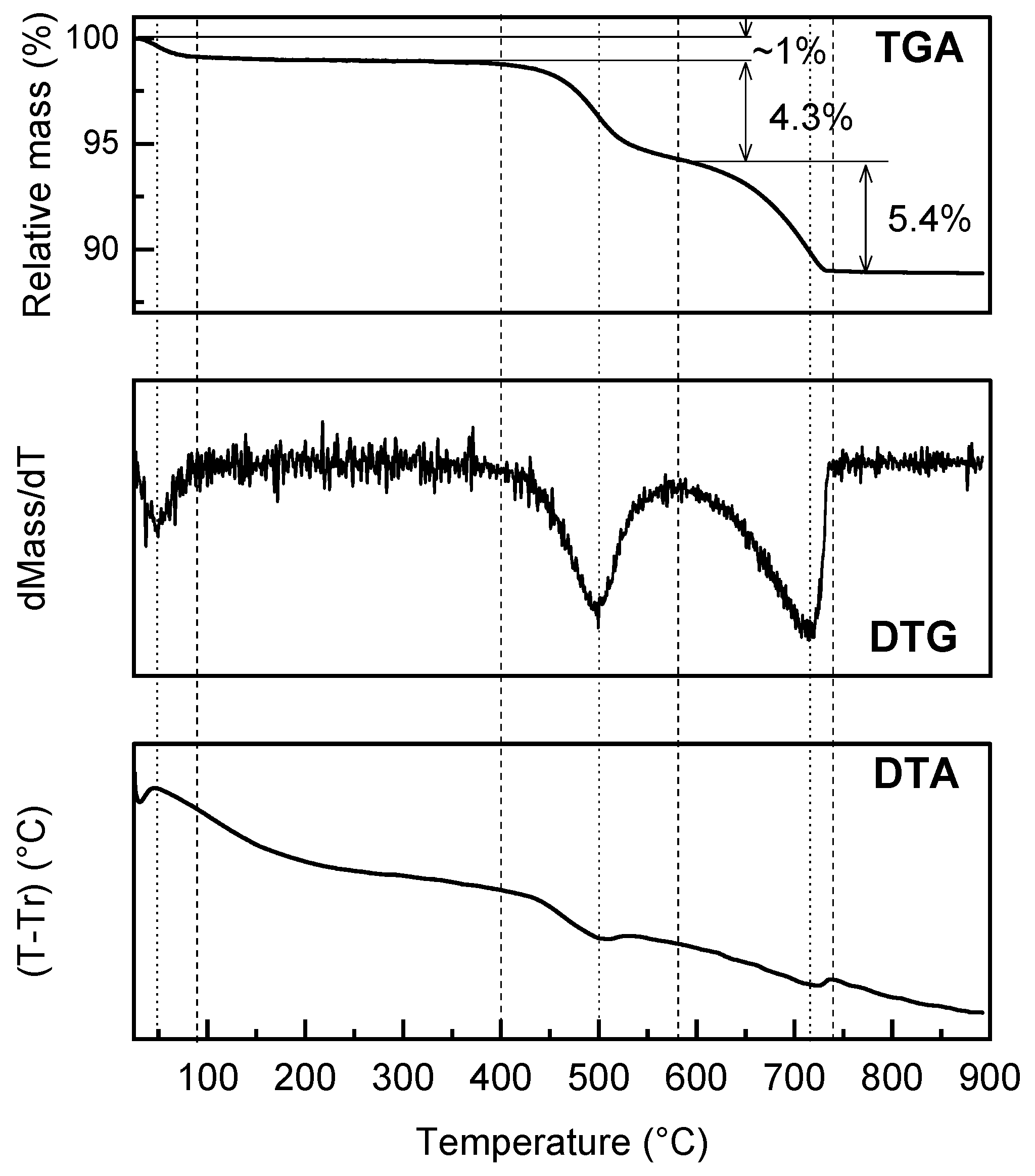
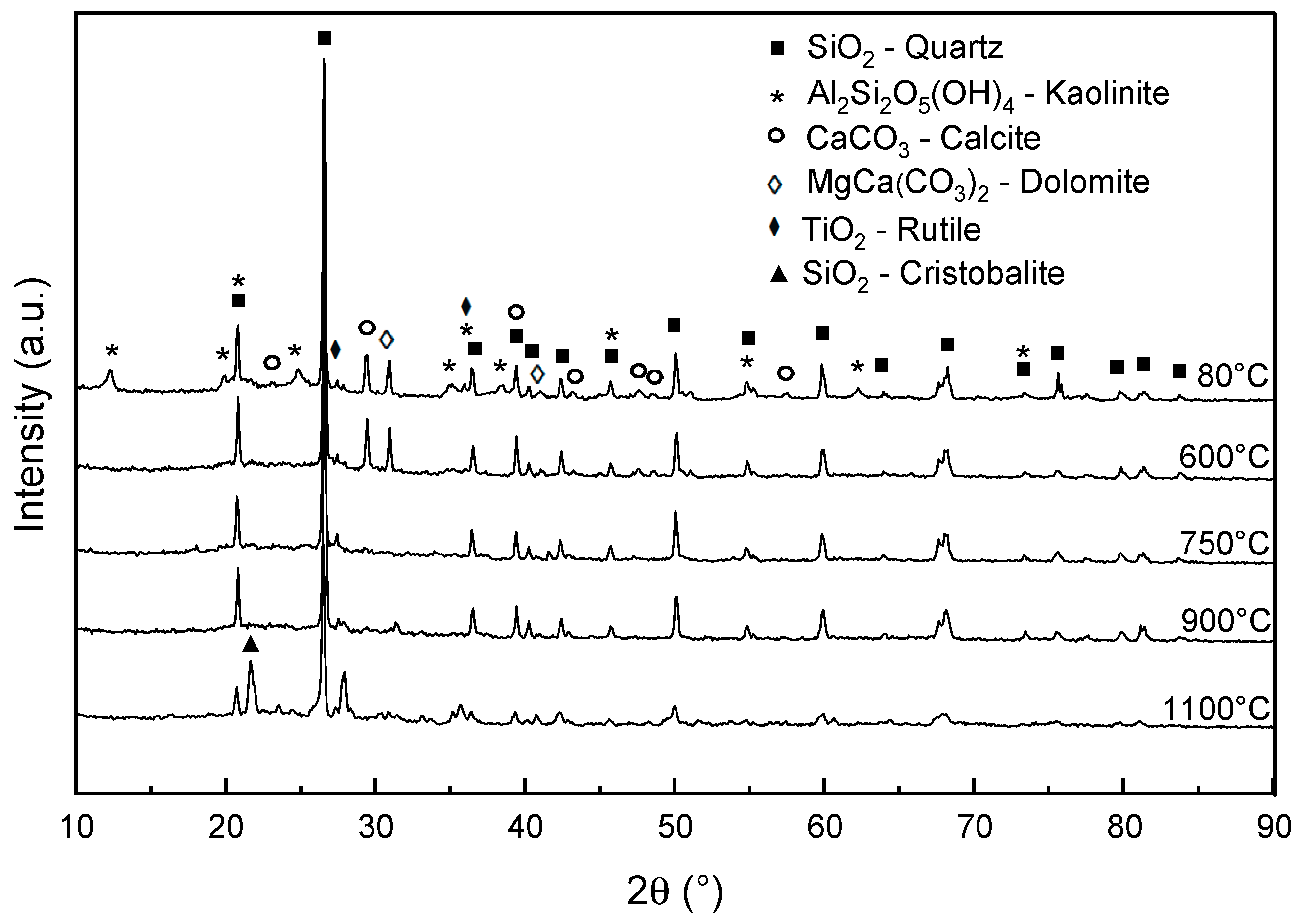
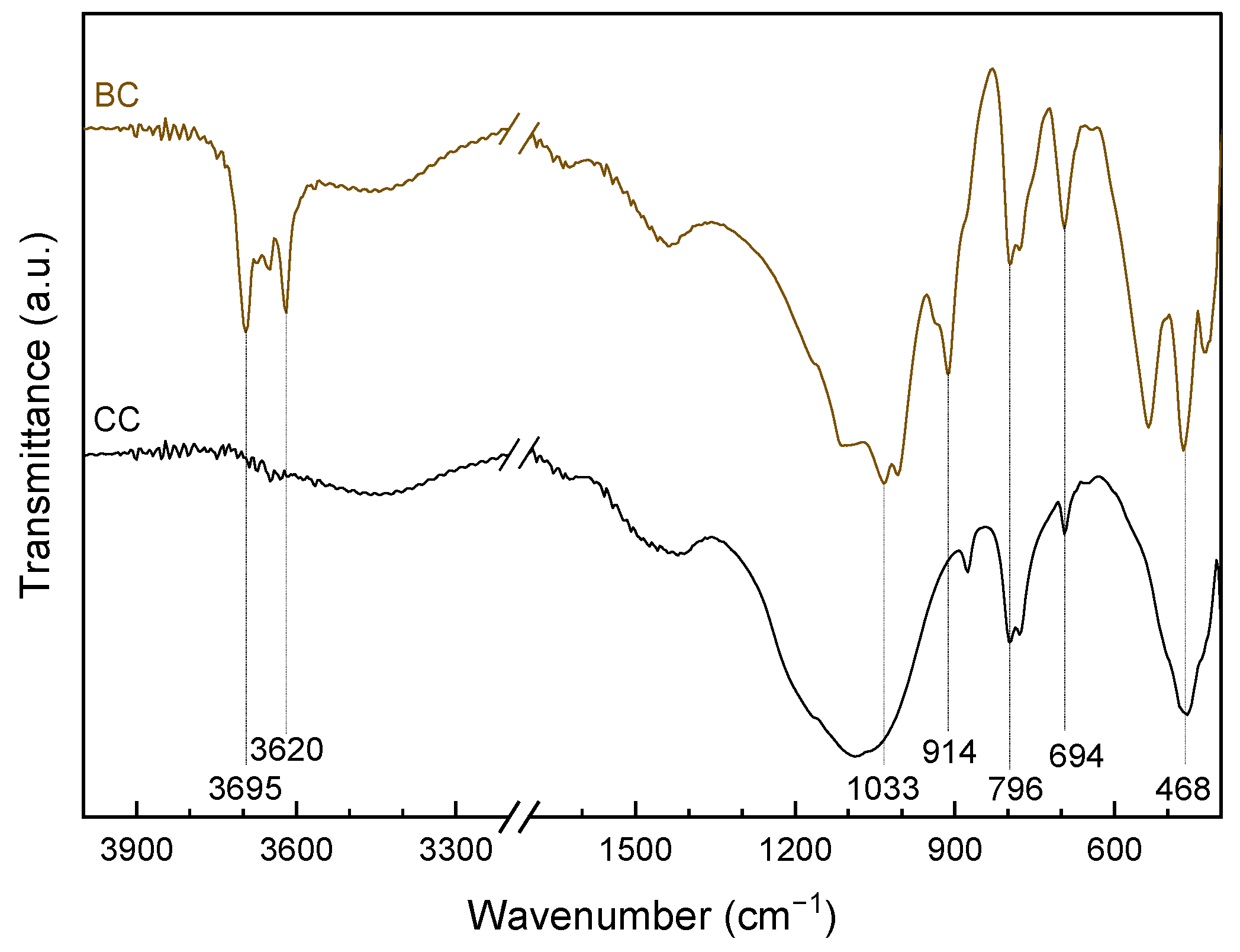

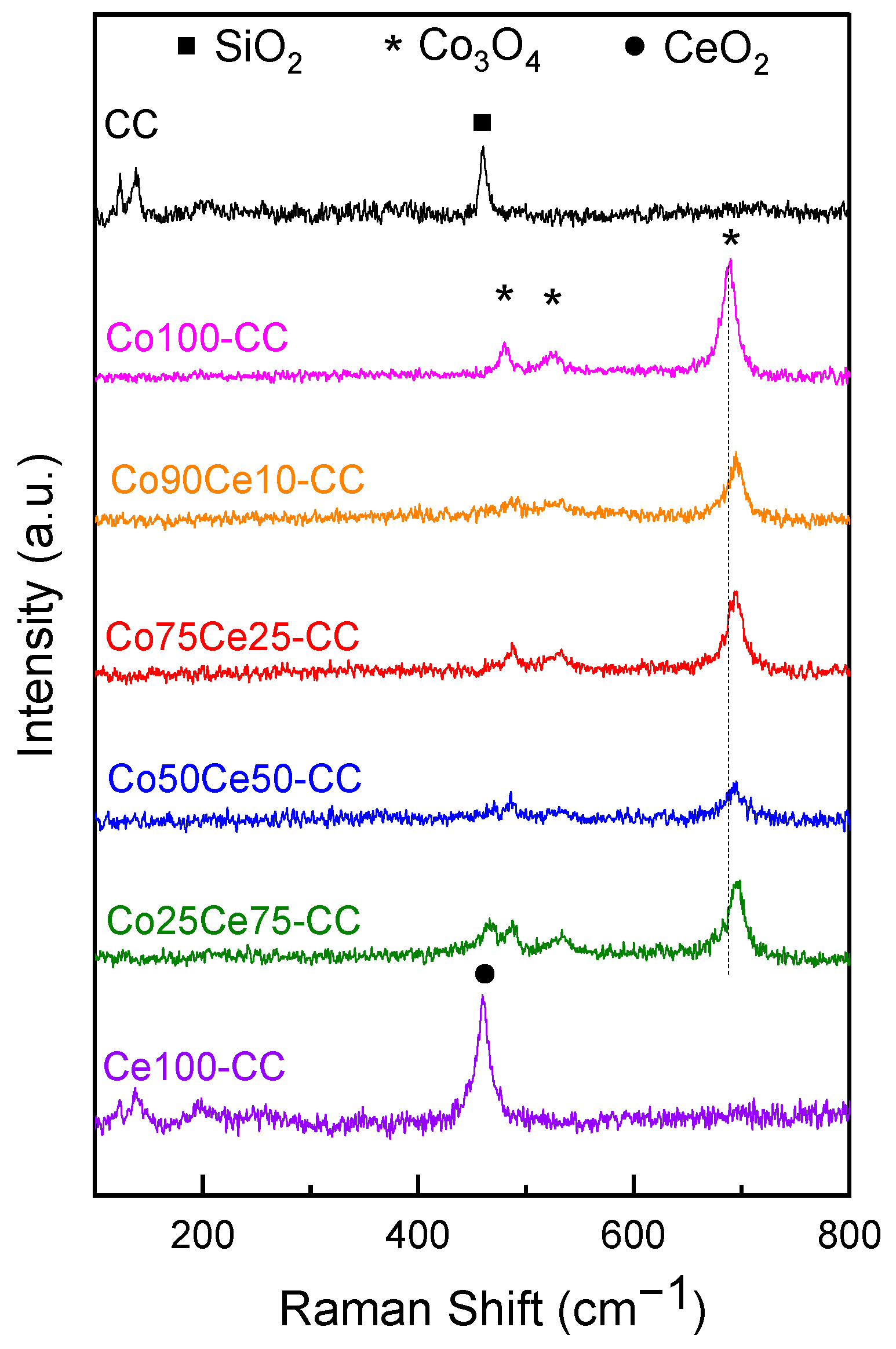



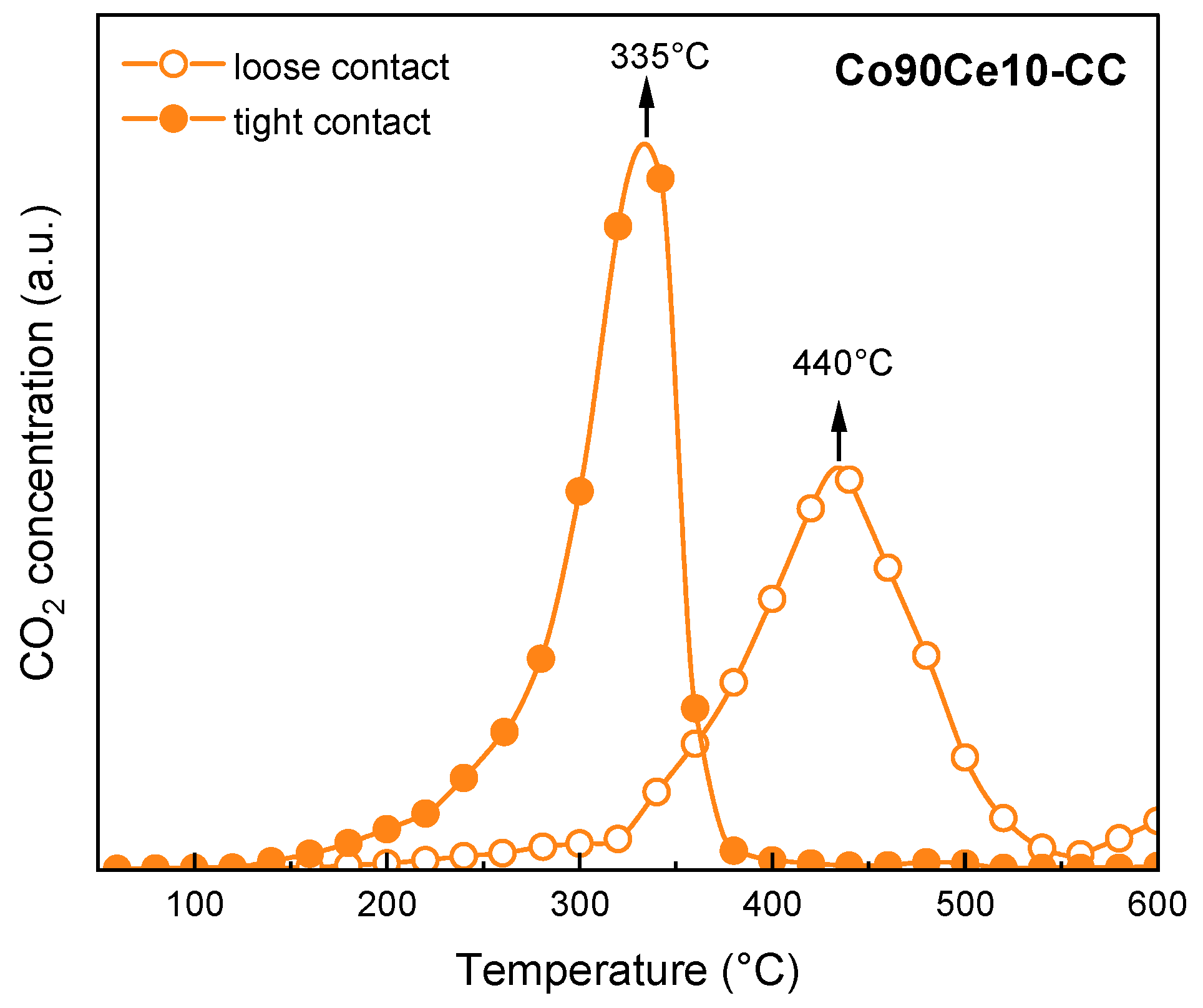
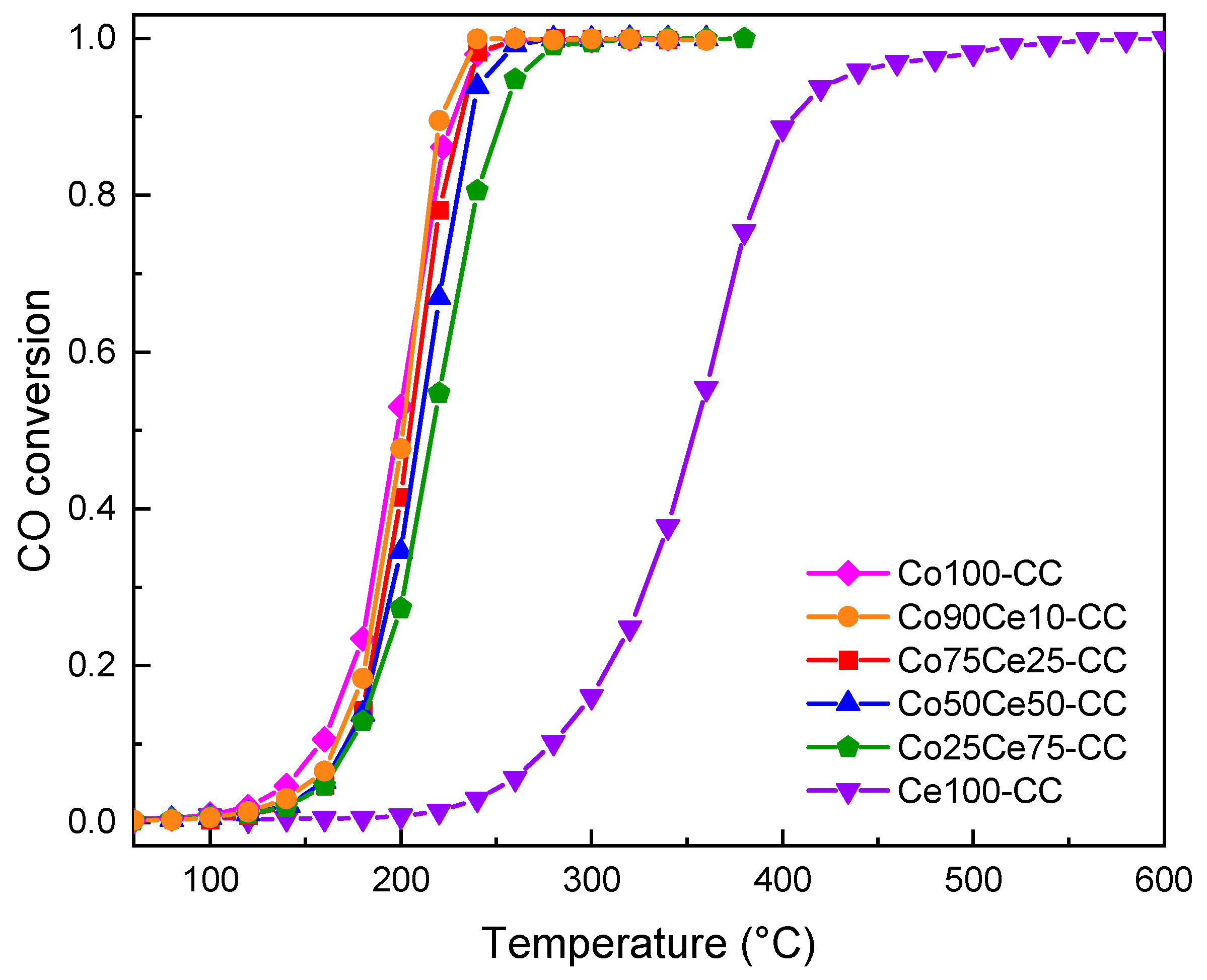
| Component | SiO2 | Al2O3 | CaO | MgO | K2O | Fe2O3 | TiO2 | BaO | ZrO2 | SO3 | LOI 1 |
|---|---|---|---|---|---|---|---|---|---|---|---|
| wt.% | 52.7 | 34.5 | 6.4 | 2.4 | 1.5 | 1.4 | 0.6 | 0.2 | 0.1 | 0.1 | 10.6 |
| Oxide | Weight Percentages (Expressed as Oxides) | |||||
|---|---|---|---|---|---|---|
| Co100-CC | Co90Ce10-CC | Co75Ce25-CC | Co50Ce50-CC | Co25Ce75-CC | Ce100-CC | |
| Co3O4 | 22.5 | 20.4 | 17.4 | 11.8 | 5.8 | 0.0 |
| CeO2 | 0.0 | 3.9 | 11.1 | 22.7 | 32.5 | 41.9 |
| SiO2 | 41.1 | 39.4 | 38.4 | 35.6 | 33.8 | 31.8 |
| Al2O3 | 27.8 | 27.5 | 26.4 | 23.3 | 21.6 | 20.7 |
| CaO | 5.3 | 5.0 | 4.9 | 4.7 | 4.2 | 3.9 |
| Elemental atomic ratios | ||||||
| 1.00 | 0.90 | 0.75 | 0.50 | 0.25 | 0.00 | |
| 1.00 | 0.92 | 0.77 | 0.53 | 0.28 | 0.00 | |
| Catalyst | Binding Energy (eV) | ΔB.E. | Isat/Imp ** | Ce3+/CeT *** | ||
|---|---|---|---|---|---|---|
| Co 2p3/2 * | Satellite | |||||
| Co100-CC | 779.5 | 780.8 | 785.4 | 15.3 | 0.41 | - |
| Co90Ce10-CC | 779.4 | 780.7 | 785.1 | 15.2 | 0.42 | 0.35 |
| Co75Ce25-CC | 779.5 | 781.0 | 785.3 | 15.4 | 0.38 | 0.27 |
| Co50Ce50-CC | 779.7 | 781.2 | 785.2 | 15.5 | 0.47 | 0.28 |
| Co25Ce75-CC | 779.6 | 781.3 | 785.7 | 15.4 | 0.78 | 0.23 |
| Ce100-CC | - | - | - | - | - | 0.25 |
| Catalyst | Soot Combustion | CO Oxidation | ||
|---|---|---|---|---|
| T10 (°C) | TM (°C) | T50 (°C) | T90 (°C) | |
| Co100-CC | 309 | 420 | 198 | 228 |
| Co90Ce10-CC | 241 | 335 | 201 | 221 |
| Co75Ce25-CC | 285 | 360 | 205 | 232 |
| Co50Ce50-CC | 307 | 404 | 210 | 237 |
| Co25Ce75-CC | 333 | 420 | 217 | 253 |
| Ce100-CC | 349 | 462 | 354 | 406 |
Disclaimer/Publisher’s Note: The statements, opinions and data contained in all publications are solely those of the individual author(s) and contributor(s) and not of MDPI and/or the editor(s). MDPI and/or the editor(s) disclaim responsibility for any injury to people or property resulting from any ideas, methods, instructions or products referred to in the content. |
© 2024 by the authors. Licensee MDPI, Basel, Switzerland. This article is an open access article distributed under the terms and conditions of the Creative Commons Attribution (CC BY) license (https://creativecommons.org/licenses/by/4.0/).
Share and Cite
Courtalón, N.L.; Milt, V.G.; Dieuzeide, M.L.; Miró, E.E.; Banús, E.D.; Bortolozzi, J.P. Co-Ce Clay-Based Materials: Their Feasibility as Catalysts for Soot and CO Oxidation Reactions. Catalysts 2024, 14, 882. https://doi.org/10.3390/catal14120882
Courtalón NL, Milt VG, Dieuzeide ML, Miró EE, Banús ED, Bortolozzi JP. Co-Ce Clay-Based Materials: Their Feasibility as Catalysts for Soot and CO Oxidation Reactions. Catalysts. 2024; 14(12):882. https://doi.org/10.3390/catal14120882
Chicago/Turabian StyleCourtalón, Natalia L., Viviana G. Milt, María L. Dieuzeide, Eduardo E. Miró, Ezequiel D. Banús, and Juan P. Bortolozzi. 2024. "Co-Ce Clay-Based Materials: Their Feasibility as Catalysts for Soot and CO Oxidation Reactions" Catalysts 14, no. 12: 882. https://doi.org/10.3390/catal14120882
APA StyleCourtalón, N. L., Milt, V. G., Dieuzeide, M. L., Miró, E. E., Banús, E. D., & Bortolozzi, J. P. (2024). Co-Ce Clay-Based Materials: Their Feasibility as Catalysts for Soot and CO Oxidation Reactions. Catalysts, 14(12), 882. https://doi.org/10.3390/catal14120882









